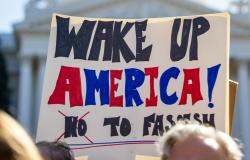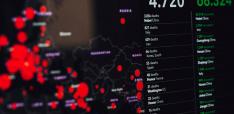From 1920s Italy to 1930s Palestine to 1980s Ska Scenes, Antifa Has Many Faces

A historian discusses past anti-fascist organizations and practices in light of Trump’s effort to criminalize “antifa.”
The United States is lurching toward neo-fascism with alarming speed, courtesy of President Donald Trump, who is using all the resources of the repressive apparatus of the U.S. state to stifle dissent and crush opposition to his extreme agenda. He is so keen on imposing his dystopian vision on the country that he has sought to criminalize anti-fascist struggle itself.
How do we fight back? In the interview that follows, Princeton University historian Joseph Fronczak and author of Everything Is Possible: Antifascism and the Left in the Age of Fascism, talks about the global history of “antifa” and the lessons we can draw from the early struggles of the anti-fascist movements in the fight against neo-fascism today.
C. J. Polychroniou: Antifa, short for “anti-fascist,” refers not to a unified, defined group but to a decentralized, leaderless network of individuals and groups that self-identify as people who confront and combat fascism and racism. The antifa concept originated in Europe in the 1960s, but its roots can be traced to the anti-fascist movements of the 1920s and 1930s. In fact, the early postwar antifa movements in Europe drew inspiration from the Arditi del Popolo movement, an Italian anti-fascist group that was founded in 1921 for the purpose of defending working-class people and institutions from the assault of Mussolini’s blackshirts. Shockingly enough, though hardly surprising given his innate proclivity for authoritarianism, Donald Trump has designated Antifa as a “major terrorist organization,” which suggests that he considers fascism to be a good thing. Can you discuss briefly the emergence of anti-fascism during the interwar period? Was it the threat of fascism that shaped the left as a “global collectivity?”
Joseph Fronczak: Let’s start with the Arditi del Popolo, which was very much the first anti-fascist organization in world history. In a lot of ways, the Arditi set the general form for anti-fascist politics since, and yet there’s not much of a historical consciousness of the Arditi today, certainly not outside Italy. As you said, the Arditi del Popolo organized themselves to defend working-class people from the violence of the fascist blackshirts. They first got organized in Rome in the summer of 1921, and right away their central idea was that they were willing to stand up to Mussolini’s squadristi; they committed themselves to militant confrontation, to a physical defiance of the blackshirts.
They did so always collectively, relying on strength in numbers. When they first got organized, it was still well before the March on Rome in October 1922, when fascism wasn’t yet a state form, when, rather, it was simply a political movement. It was a very violent political movement, carrying out a sprawling campaign of terrorism. Yet — it’s worth pointing out, not only because you brought up Trump’s “terrorist” designation — the Arditi del Popolo didn’t respond to terrorism with terrorism. They always remained, rather, committed to a very disciplined collective practice of working-class defense. They mobilized to fend off fascist domination, and they did so without mirroring the fascists’ terror tactics or countering them with terrorist violence in kind.
That discipline, though, wasn’t imposed on members from above. The Arditi del Popolo was a radically egalitarian, horizontally organized group. Members were empowered to take on ethical responsibility. You can get a sense of that ethic from the group’s name: “Arditi” is a word in the plural form, meaning the “daring ones.” To speak of just one member would be to speak of an “ardito,” with an “o” at the end. But, tellingly, the Arditi del Popolo as a rule simply didn’t do this. Instead, they were always conjuring themselves in the form of the collective. The name of the group also got across the message that there was no fundamental distinction among the members; their common identity, Arditi, spoke to their fundamental equality within the group. The rest of the name, “del Popolo,” means “of the People.” This communicated the Arditi’s deeply felt populism. They understood themselves as the people’s front line of defense, or even the shield of the popular will.
The Arditi del Popolo also prefigured the anti-fascist politics to come in a lot of other simple but significant ways. They were cross-ideological, composed of anarchists, communists, socialists, radical republicans: very much a big-tent group, with no one constituent part dominating. It followed that the group’s members belonged to a number of Italian political parties — even though the leaderships of those parties were hostile to the Arditi del Popolo. Despite that, the Arditi del Popolo quickly became a powerful movement, in part because as a group, whenever they mobilized, they cut such a charismatic collective figure. They understood well the power of political aesthetics, the potential for drama in politics’ performative enactment. They marched to demonstrations with a highly stylized performativity; they sang songs and wore vivid colors; their public appearances were full of dramatic gesture and heroic posture. That is to say, they didn’t just defend working-class meetings and neighborhoods from fascists; they did so dramatically, cinematically.
When the fascists took state power in Italy in 1922, the new government quickly moved to suppress the Arditi del Popolo. So it was a short-lived group. But for one reason or another, all their qualities I’ve mentioned became meaningful parts of anti-fascist politics in the years that followed — most centrally, the commitment to direct, collective, often physically courageous confrontation with fascism.
In the 1930s, anti-fascism became a global cause. The global anti-fascism that announced itself with its immense mobilization during the Spanish Civil War had a lot of qualities in common with the Arditi del Popolo — some of the Italian anti-fascists who had been in the Arditi del Popolo back in 1921 and 1922 went to Spain to fight world fascism there in 1936 and 1937.
The anti-fascist movements of the interwar period suffered from ideological and political divisions, which turned out to be quite detrimental in the fight against fascism and Nazism. For instance, a united front against Nazism was needed in Germany, but both the Communists (KPD) and the Social Democrats (SPD) refused to create one. The KPD founded Antifaschistische Aktion (Antifascist Action) whose purpose was to organize resistance against the Nazi movement, while the SPD had the Eiserne Front (Iron Front). The anti-fascist movement in Spain during the Spanish Civil War also suffered from similar problems. Do you think that these ideological and political divisions, which continue to plague the left to this day, impact on the mission of anti-fascism as a transnational movement?
No doubt. But I don’t think leftists should go on endlessly performing ritual mass self-flagellation over this. The left’s full of sectarianism, betrayals, grudges, and philosophical divisions. OK, let’s get over it. Transnational movements are hard to pull off, and multi-ideological political blocs, comprised of people from rival parties, are hard to pull off. The people who have built the left over the decades have had real differences of material interest, social identity, and philosophical passions. To my mind, the surprise isn’t that the left has divisions; to my mind, the surprise — the conceptual miracle — is that there’s still this notion of the left, of a shared political home, in spite of the many, real differences. And not just still a notion of the left; there’s still a shared persistent underlying commitment to the notion.
A bi-national Antifa movement also sprung up in Palestine in the 1930s, mainly in order to counter right-wing Jewish organizations and to advocate for a shared future between Arabs and Jews. What happened to that movement?
That movement got swallowed up by history. I said there’s very little historical consciousness of the Arditi del Popolo today. But Antifa of Palestine is much, much more obscure to us. There’s a lot to learn, though, by thinking through the history of this small militant collectivity.
It was maybe the first group outside Europe ever to describe itself as Antifa. You mentioned Antifaschistische Aktion in Weimar Germany — that group was created in Berlin in 1932. So the comparisons to the Arditi del Popolo are obvious: a fierce, aesthetically brilliant, and physically courageous anti-fascist group created one year before fascists took state power. And then just as the Arditi del Popolo were quickly smashed in Mussolini’s Italy of 1922 so too was Antifaschistische Aktion quickly smashed in Hitler’s Germany of 1933. During its lifespan, though, unlike the Arditi del Popolo, Antifaschistische Aktion was firmly controlled by one political party, the German Communist Party, which used the group as a weapon for raiding the membership of its main rival, the German Social Democratic Party. All the same, Antifaschistische Aktion was genuinely committed to collective defense against fascism; and the group went by the nickname Antifa. Talk of “antifa” as a shorthand for antifascism — and even signifying a certain sort of antifascism — began in Weimar-era Germany.
Then, in 1934, when Arab and Jewish social revolutionaries in Palestine got organized to work together against fascism and imperialism and toward a shared social revolution of Palestine’s Arab and Jewish peoples, they called themselves Antifa of Palestine. The group sought to liberate Palestine from the British Empire; Antifa’s members accused Britain of intentionally dividing Arab and Jewish people in Palestine so better to rule them. They interpreted fascism as a snare laid by empire: It was a politics of race hatred and national chauvinism that prevented what was truly dangerous to the empire: a politics of interracial, international solidarity. Antifa of Palestine was intent on warning Jewish workers against Zionism, Arab workers against Arab nationalism: to subscribe to any form of nationalism was to follow fascist logic.
Likewise, to fall into political violence was to follow fascist logic. Antifa of Palestine sought a social revolution but stressed that the revolution had to be peaceful or it would be no true revolution at all. Fascism produced violence; violence produced fascism. Antifa of Palestine stressed peaceful grassroots political organizing as the practical form of anti-fascism — fascism’s inverse.
The force of events in the late 1930s broke Antifa of Palestine. Whereas I think the Arditi del Popolo have this immense unrecognized legacy, I think the deeper value of learning about the history of Antifa of Palestine has to do with making sense of a bold, pacifistic, social revolutionary vision that was snuffed out before it could burn bright, before it could generate a big brilliant legacy. Other pasts could have happened, other worlds are possible.
When did Antifa reach the United States? What was its primary mission and what impact did it have?
Well, with Antifa of Palestine in mind, it’s only fair to point out that I think they were the first to carry antifa to the United States. In 1937, two anti-fascists from Palestine, one Jewish and one Arab (Morris Efrom of Tel Aviv and Najib Yusuf of Jaffa, respectively), came to New York and tried to cultivate some long-distance solidarity with their cause.
But the more direct link to the sort of politics that people know today as antifa took form in the United States in the 1980s, when anti-fascist skinhead youths organized groups like Anti-Racist Action in the Twin Cities and SHARP — Skinheads Against Racial Prejudice — in New York City. This was part of a global movement of skinhead anti-fascism — youths who were part of punk and ska and Oi! music scenes organizing antifa politics. They started the work of piecing together what antifa politics looks like today: a sort of stripped-down anti-fascist politics, even a back-to-basics anti-fascism fiercely protective of core anti-fascist principles.
In your book Everything Is Possible: Antifascism and the Left in the Age of Fascism, you argue that the anti-fascist solidarity in the 1930s created the left as we know it today. Can you elaborate on the connection between the anti-fascist left of the 1930s and the left of today?
Anti-fascist principles have been sticky for the left, like a glue, holding things together. This relates to what I said before — yes, the left is full of divisions, but the simple idea of the left — the idea that there is this big global collectivity of people who share an expectation of solidarity with each other in causes of equality and emancipation — this is a tremendously valuable political resource. It shouldn’t be taken for granted. And in the book, I try to piece together the historical making of that political resource. Before the anti-fascist left of the 1930s, there wasn’t a concept available for conjuring a world-spanning political bloc anything like what we now think of as the left. Sometimes historians write about “the nineteenth-century left” or something like that, but at the time nobody had such a notion. That lack impeded things. Imagining the left into form was something that happened in the fight against fascism in the years leading up to and culminating in the Second World War.
Fascism is on the rise again. How do we combat fascism today? And what impact do you think that Trump’s designation of Antifa as a “terrorist” organization might have on the fight against the emerging dictatorial regime in Washington, D.C., and of fascism in general?
When Trump does something like designate Antifa a terrorist organization, I don’t think he’s interested in asserting the specific claim that the syntax of his words would suggest. I think he’s wedging words and phrases together to achieve a general effect; what he’s doing is more of a brutish semiotic act than an utterance of ideas organized into a reasoned sequence of claims.
He’s even throwing together different discourses. He’s drawing on the discourse of the “global war on terror” — with the premise of an official designation of a group as terrorist and with the line, in the executive order, that “Antifa” “recruits, trains, and radicalizes young Americans” — and he’s drawing on the generic discourse of federal legal prosecution — the premise that antifa is an “enterprise,” as it’s termed in the executive order, as if he were framing RICO charges or something like that.
Trump jams together the jargon of these discourses to make a blunt political point. It’s an abuse of power. Of a sort that’s very common with him. What’s the impact? I think he solidifies in the minds of his supporters an image of antifa kids as the nation’s enemy within.
As for “How do we combat fascism today?” The way you put the question is helpful for answering it. The “we” is the hardest part. Who’s “we?” Getting that clear in your head puts a lot in motion. I think we fight fascism today by sticking together with the people who show up to fight fascism, and I think we fight fascism by sticking up for people who are targeted by the right and the powers that be. Sometimes you’re one of the targeted, sometimes maybe you’re not. The “we” ought to include both.
But sticking together with people who have in mind a different endgame from the one in your head and sticking up for the scapegoated and the targeted are hard things to do. Studying history, though, has a way of clarifying elements of practice. Learn from the examples of people who have done things in the past that you admire; learn too from the examples of people who have messed up.
C.J. Polychroniou is a political scientist/political economist, author and journalist who has taught and worked in numerous universities and research centers in Europe and the United States. Currently, his main research interests are in U.S. politics and the political economy of the United States, European economic integration, globalization, climate change and environmental economics, and the deconstruction of neoliberalism’s politico-economic project. He is a columnist for Global Policy Journal and a regular contributor to Truthout. He has published scores of books, including Marxist Perspectives on Imperialism: A Theoretical Analysis; Perspectives and Issues in International Political Economy (ed.); and Socialism: Crisis and Renewal (ed.), and over 1,000 articles which have appeared in a variety of journals, magazines, newspapers and popular news websites. Many of his publications have been translated into a multitude of languages, including Arabic, Chinese, Croatian, Dutch, French, German, Greek, Italian, Japanese, Portuguese, Russian, Spanish and Turkish. His latest books are Climate Crisis and the Global Green New Deal: The Political Economy of Saving the Planet (with Noam Chomsky and Robert Pollin as primary authors, 2020); The Precipice: Neoliberalism, the Pandemic, and the Urgent Need for Radical Change (an anthology of interviews with Noam Chomsky, 2021); Economics and the Left: Interviews with Progressive Economists (2021); Illegitimate Authority: Facing the Challenges of Our Time (an anthology of interviews with Noam Chomsky, 2023); and A Livable Future Is Possible: Confronting the Threats to Our Survival (an anthology of interviews with Noam Chomsky, 2024).
This first appeared on TruthOut.
This article is licensed under Creative Commons (CC BY-NC-ND 4.0), and you are free to share and republish under the terms of the license.
Photo by Stephen Leonardi


